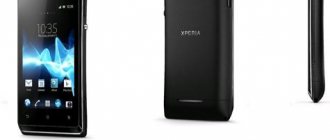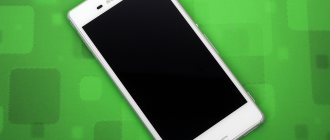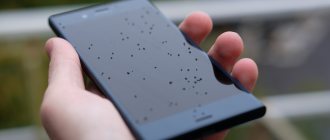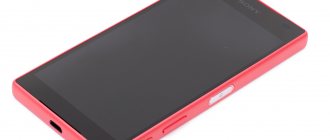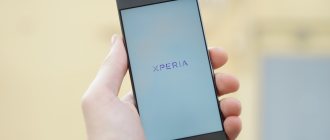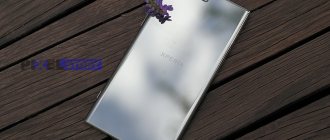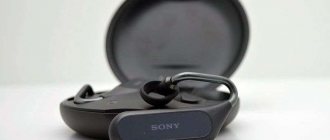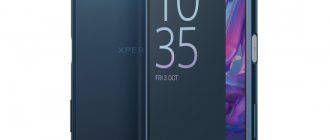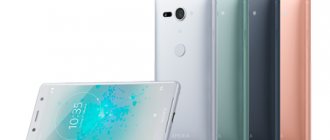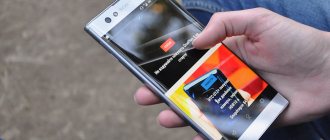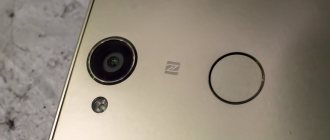This smartphone has a widescreen display with a cinematic aspect ratio of 21:9, which is convenient both for entertainment and for simultaneous work in two applications. The emphasis is also on high-quality audio technologies and universal fast charging. The rest of the hardware looks much more modest, including, in particular, a medium-power processor with small memory reserves and a completely ordinary rear photo duo. Vesti.Hi-tech found out what else is interesting about the Sony Xperia 10.
Sony presented an updated line of its Xperia smartphones at MWC 2020. Now it includes the flagship Xperia 1, which is joined by the mid-range Xperia 10 and 10 Plus. Moreover, the main “feature” of the new line was the screen in the proportion 21:9 with narrow frames. As you know, not only Hollywood blockbusters are made in cinematic format (21:9 = 2.33:1), which is close to anamorphic (2.35:1), but also popular concert recordings and various video clips. In addition, widescreen screens on smartphones provide more space for organizing multi-window mode. Let us recall that experts predicted a display in a 21:9 aspect ratio back in 2020 for the failed Sony Xperia X Ultra model.
Sony Xperia 10 review: technical specifications
- Model: I4113
- OS: Android 9 (Pie) with Xperia proprietary shell
- Processor: 14nm 8-core 64-bit Qualcomm Snapdragon 630 (MSM8998) 8-core ARM Cortex-A53 architecture (up to 2.2 GHz)
- Graphics subsystem: Adreno 508
- RAM: 3 GB
- Storage: 64 GB, eMMC, microSD/HC/XC combo memory card slot (up to 512 GB)
- Screen: widescreen, 6 inches, IPS, FHD+ (2520x1080 pixels, 21:9), pixel density per inch 457 ppi, protective glass Corning Gorilla Glass 5
- Rear photo module: main camera - 13 MP (optical size 1/3 inch, pixel 1.12 microns), wide-angle lens (viewing angle 76.4 degrees), phase detection autofocus, EGF 27 mm, f/2.0 aperture; auxiliary camera - 5 MP (optical size 1/4 inch, pixel 1.4 microns), wide-angle lens (viewing angle 87.9 degrees), EGF 22 mm, aperture f/2.4; LED flash, video [email protected] , [email protected]
- Front camera: 8 MP, (optical size 1/4 inch, pixel 1.12 microns), wide-angle lens (viewing angle 84 degrees), f/2.4 aperture, EGF 24 mm, video [email protected] , slow motion 120 fps
- Network: GSM/GPRS/EDGE (2G), UMTS HSPA+(3G), LTE (4G) Cat.13/Cat. 12
- Interfaces: Bluetooth 5.0 (aptX/aptX HD), Wi-Fi 802.11 b/g/n (2.4 GHz + 5 GHz), Google Cast, NFC, USB Type-C (USB 2.0, OTG)
- SIM card format: two nanoSIM (4FF)
- Sound: SmartAmp, High-Res Audio, DSEE HX
- Radio: FM tuner
- Navigation: GPS/GLONASS, A-GNSS
- Sensors: accelerometer, light and proximity sensors, gyroscope, compass, Hall sensor, pedometer, fingerprint scanner
- Battery: non-removable, lithium-ion, 2,870 mAh, Smart Stamina, supports USB PD fast charging and Qnovo adaptive, Battery Care
- Dimensions: 156x68x8.4 mm
- Weight: 162 g
- Color: black, silver, dark blue, pink
Technical specifications Sony Xperia X
Detailed technical specifications Sony Xperia X is a model that can safely be called the “golden mean” of the new X-series. The smartphone received a stylish design and a solid metal body, rounded glass on the screen, excellent hardware and powerful camera modules: 23 and 13 Megapixels. The model is aimed at people who want to have a stylish smartphone with ample photo capabilities and sufficient performance.
As you know, the model is available in two versions - with one or two SIM cards. Moreover, please note that the dual-SIM version of the internal memory has as much as 64 GB, and the price is almost the same.
Sony Xperia X specifications:
Design, dimensions
- Size – 142.7 x 69.4 x 7.9 mm
- Weight – 153 g
- Metal body and cover, rounded 2.5D glass, fingerprint scanner, splash resistant
- Case colors: White, Graphite black, Gold, Rose gold
Display
- Size – 5 inches
- Resolution – 1980 × 1080 pixels
- Pixel Density – 441 pixels per inch
- Display technology – IPS LCD
- Technologies TRILUMINOS Display, X-Reality for mobile devices, Dynamic Contrast Enhancement
Camera – photo
- Main camera – 23 Megapixels
- Intelligent Hybrid AF
- 1/2.3" Exmor™ RS Sensor
- 24mm wide-angle G Lens with F2.0 aperture
- 5x Clear Image zoom without loss of quality
- SteadyShot image stabilization with Smart Active mode
- Fast startup (less than 0.03 s)
- HDR mode for photos and videos
- Face and Smile Detection, Auto Best Mode, White Balance, Burst Mode, Camera Apps, Effects
- Front camera – 13 Megapixels, 1/3-inch Exmor™ RS sensor, autofocus, 22mm wide-angle lens with F2.0 aperture, effects, HDR, SteadyShot stabilization
Camera - video
- Recording capability: 4K for the main camera and Full HD video for the front camera
Sony Xperia X specifications – Hardware
- Qualcomm Snapdragon 650 (8956)
Processor and video
- 64-bit, 8-core, 1.8 GHz, (ARM Cortex-A72 and ARM Cortex-A53 cores)
- Graphics chip – Adreno 510
RAM
- Volume – 3 GB
Inner memory
- 32 GB in single SIM model
- 64 GB in dual SIM model
- Expandable via MicroSD, MicroSDHC, microSDXC up to 200 GB
Battery (according to Sony Mobile)
- Battery capacity – 2620mAh
- Qnovo Adaptive Charging technology
- STAMINA and Ultra STAMINA modes
Software and multimedia
- Android 6.0 system
- PlayMemories
- PS4™ Remote Play
- FM radio receiver with radio data transmission system
- Music
- Camera
- Album
- Video and TV Sideview
- Movie Creator
- Track ID
- What's New
- Weather
- Spotify
- Sony's suite of multimedia applications
- PlayMemories
Audio
- Clear Audio+, Clear Stereo, Clear Bass, Clear Phase
- X-Loud
- S-Force Front Surround
- Dynamic normalizer
- Digital Noise Reduction
- High Resolution Audio (LPCM, FLAC, ALAC, DSD)
- DSEE HX
- LDAC
- FM radio
- Stereo recording
- Xvid/MP4/H.265 player
- MP3/eAAC+/WAV/Flac player
- TrackID music recognition function
Connections and sensor
- Bluetooth 4.2
- GPS, A-GPS, GLONASS
- WiFi 802.11
- USB 2.0
- NFC
- Other – DLNA, Tethering, Computer sync, OTA sync
- Accelerometer, gyroscope, compass, voice control, proximity sensor
Networks
- GSM GPRS/EDGE (2G)
- UMTS HSPA (3G)
- LTE (4G) Category 6 (not available in all regions)
- Sony Xperia X Dual version with two SIM cards
Model options:
Sony Xperia X (F5121)
Sony Xperia X Dual (F5122)
Sony Xperia 10 review: design, ergonomics
The Xperia 10 smartphone looks surprisingly “long” at first glance – it’s all about its widescreen display with an aspect ratio of 21:9.
However, the usual angular body turned out to be quite compact and easily fit in an average-sized palm, without trying to fall out of it under its own weight.
The overall dimensions of the 6-inch Xperia 10 are 156x68x8.4 mm, and the weight is 162 g. And the magic of this smartphone is that it does not seem thick or heavy.
Note that the material for the back panel is metallized plastic, which not only feels pleasant in the hand, but also does not slip in it. It’s no secret that spectacular “remnants”, constantly striving to break free, are best kept in a case at all times.
There are four body colors available for sale: black, silver, dark blue and pink. As usual, a smartphone in the mid-price category lacks protection from dust and moisture.
The front panel of the Xperia 10, including the screen, is entirely covered with protective glass Corning Gorilla Glass 5.
If the “chin” does not exceed the width of the side frames, then on the high “forehead” there is enough space to place the front camera lens, a decorative speaker grille, an LED charging/notification indicator, as well as light and proximity sensors. True, the Sony logo is no longer here.
At the bottom of the display, space is reserved for the control panel - two or three virtual buttons, depending on the selected setting.
The USB Type-C (USB 2.0) connector at the bottom end of the case is surrounded by two decorative grilles, under one of which there is a “multimedia” speaker, and under the other there is a hole for a “conversational” microphone.
The hole for the second microphone and the 3.5 mm connector for an audio headset (people rejoice!) are on the top end.
The volume rocker and the power/lock button on the right edge were prudently moved down a little, and a fingerprint scanner pad was placed between them. Unlike the slightly recessed surface of the fingerprint sensor, both mechanical buttons are made almost flush, which sometimes makes them difficult to find by touch.
On the left edge there is a slot covered with a lid that is easy to pry off with a fingernail. On the lid there is a tray intended for the first subscriber identification module (nanoSIM format). Another tray, not connected to the lid (again, literally removed manually), is designed to install a second nanoSIM or microSD memory card.
The back panel of the smartphone is decorated with Sony and Xperia logos.
In its upper part, in the center, there is an LED flash, under which two lenses of the rear photo module are placed horizontally on an island protrusion. The NFC antenna area is marked with an icon.
As already noted, the Xperia 10 turned out to be quite compact, however, the smartphone’s settings included tools for convenient one-handed operation, including Side Sense.
Android on the big screen: Sony Ericsson XPERIA X10 review
With the release of the XPERIA X10, Sony Ericsson is entering a new segment of smartphones running the Android operating system. The device, announced last November, promised flagship performance thanks to its gigahertz processor and boasted the largest 4-inch display. Judging by the activity of competitors who announced their older models on Android, this year (at least the first half of the year) the X10 will remain the only device with such a large screen.
A little history
The first model of the XPERIA line was announced with fanfare and, on the one hand, caused a bombshell at MWC 2008, since it meant a sharp turn in the company’s strategy and the abandonment of its own UIQ platform, which the company had been developing almost single-handedly for several previous years (and only in the last year - together with Motorola) in favor of Windows Mobile. On the other hand, the XPERIA X1 smartphone apparently did not live up to the expectations placed on it. It came out late, the proprietary add-on to the Windows Mobile interface was crude, clumsy and frankly inferior to the HTC TouchFLO 3D shell with its beauties. Therefore, the announcement of the X10 and the index that opened the new “top ten” looked like a breath of fresh air and the embodiment of the hopes of the company’s shareholders and all fans of the brand. In essence, it was a transition comparable to replacing the flagship P990 smartphone with the new sleek P1. Logic dictated that a gigahertz processor and the same 4-inch (and capacitive) screen with a high resolution of 858x480 pixels should have yielded results. And the transition from the clumsy and problematic Windows Mobile in many respects to the Android operating system, beloved by all geeks (and at the same time having a lot of prospects for development), also could not but inspire confidence. True, almost immediately the issue with the version of the operating system arose - Donut (1.6) looked suspicious against the backdrop of emerging announcements of flagship models of competitors on ?clair (2.1). The issue remains unresolved to this day - there is hope for an update to the Android version, but it is unknown when this will happen. But the expected price for the X10 has dropped significantly from the pessimistic amount of $800-1000, and according to the latest data, the device can be expected to be significantly cheaper in Ukrainian retail. At the start of sales, the retail price will be at the level of 5300-5500 hryvnia.
Technical specifications Sony Ericsson XPERIA X10
What do you need to know about the technical characteristics of the Sony Ericsson XPERIA X10 besides the processor and screen already mentioned twice? The device has an 8-megapixel camera with video recording in a resolution of 800x480 pixels. One gigabyte of built-in memory (we are talking about ROM, although the amount of RAM is more important, in fact) and support (weak link) for cards with a capacity of up to 16, not 32 gigabytes. A battery with a capacity of 1500 mAh seems to be a standard solution for devices of this class today, but in practice, competing devices are slightly inferior to it.
| Dimensions | 119x63x13 mm |
| Weight | 135 g |
| operating system | Android 1.6 (Donut) |
| CPU | Qualcomm Snapdragon QSD8250, 1 GHz |
| Display | capacitive, TFT, 4″, 854x480 pixels, 65,536 shades |
| Memory | 1 GB + microSD up to 16 GB |
| Camera | 8 MP (3264×2448 pixels), autofocus, video recording 800×480 (28 fps), LED backlight |
| Communications | Wi-Fi, A-GPS, Bluetooth 2.0 A2DP, HSPA (up to 7.2 Mbit/s) |
| Battery | lithium polymer, 1500 mAh |
| Delivery colors | black White |
Competitive environment
Direct competitors in the global market of Sony Ericsson XPERIA X10 are, in fact, two models: HTC Desire and Acer Liquid e. Taking into account the fact that the Ukrainian representative office of Acer soberly assesses its capabilities and does not plan (for now, just for now) to get involved in this difficult market segment (in this situation, it would be logical to wait for the time when the word Android stops sounding exotic in ordinary stores and in each there will be one, or even better, two shelves with Android devices), the only competitor to the X10 in our area will be the HTC Desire, which, due to its HTC Sense interface, is even more attractive than the Nexus One, which is its complete analogue. At the same time, the price for HTC Desire is promised at $630, which could pose a serious problem for sales of the XPERIA X10. Although Sony Ericsson has greater (compared to HTC) brand recognition (and therefore customer trust). In general, the biggest problem with the X10 remains the older version of the operating system, which can be forgiven for a mid-range device, but is difficult to forgive for a flagship.
Appearance of Sony Ericsson XPERIA X10
Externally, Sony Ericsson XPERIA X10 looks very decent. Thin body, huge screen that just screams “only tablets are bigger than me!” and a scratch-resistant screen protector. It's worth watching the video, especially since we've done a little work on the bugs, improving the sound, image and converting all video footage to 16:9 format.
The phone will come in two color options – black and white. I prefer the white one, it is much less easily soiled; in order to see the greasy stains on the back cover, you need to catch the “correct” angle of view. The lid is varnished and very pleasant to the touch.
At the top end there is a power button (it is also used to lock the screen), a headphone jack and a microUSB socket hidden by a plug (the battery is charged through it). At the bottom there is only a microphone.
The right side panel houses a predictable rocker key for volume control and a camera button. On the left there are only two holes; behind the larger one, by the way, there is a speaker for music. Pay attention to the chrome curve line - it is reminiscent of the signature Human Curves design.
There are three hardware keys. In my opinion, this is the perfect set for Android. The central one returns the user to the desktop, the left one calls up the context menu, the right one performs the function of returning to the previous menu level. The keys themselves are thin, but wide, with shallow travel, making them comfortable to use.
Next to the speaker is not a camera for video calls, but a bunch of sensors that have already become standard for modern phones. They are needed to automatically adjust the screen brightness and turn off the display during a call. Once again I draw your attention to the protective coating plate - in this photo you can clearly see its edge in the place where it bends, making room for the speaker.
The lid can be removed without any movement - you just need to “tear it off” by picking it up with your fingernail from below. The lid itself is thin, so doing this is downright scary at first. But then you get used to it. I remember that Nokia most often suffers from such covers. But calling this a disadvantage is hardly appropriate. It’s just that over time the fear of damaging the lid goes away on its own. Pay attention to the placement of the battery - it blocks the memory card, making it impossible to hot-swappable. To do this, you have to remove the battery.
The battery capacity is 1500 mAh. Not exactly a record, but rather an expected and adequate indicator. By the way, HTC Desire has a battery capacity of 1400 mAh, although such a small difference is unlikely to be noticeable.
The placement of the memory card and SIM card is made as simple as possible, without charades or any fasteners. Noteworthy is the special diffuser covering the backlight LED. Although I would prefer to see a xenon flash in its place.
XPERIA X10 compared to Nokia N97 and Sony Ericsson Vivaz.
It's funny that the plastic of both Sony Ericsson phones looks nicer, although it is glossy and, logically, should be more easily soiled. It's probably all about the light-colored cases.
XPERIA X10 is frankly large in size, but thin.
If the large size of the device may seem excessive to some, then in horizontal orientation while viewing web pages or videos, this disadvantage instantly turns into an advantage. Overall, despite its rather large size, the phone does not seem bulky. The only thing it can be reproached for is its worn-out screen. But this drawback is inherent in any phone with a touch screen.
Menu Features
Speaking of the interface, it’s time to say that what we had in our hands was not a commercial, but a pre-sale sample of the phone. In a comment to this video on YouTube, one of the service users who watched it wrote that perhaps we are talking about old firmware, less sensitive to pressure and significantly slower. I would be glad if everything is different in the sales copies. Although, I must admit, it was always difficult for me to understand what could be changed here with the firmware. And practice shows that in most cases little changes in the final samples, we are mainly talking about cosmetic changes. It is worth saying that the speed of operation directly depends on the number of running applications. As you know, Android is very cool about the idea of closing applications - a significant part of programs do not have such an option at all, and they can only be closed using a special utility. For the sake of formality, I will say that I had a device with firmware R1FA005, 2.6.29-rel [email protected] #2.
The main impressions of the interface are three desktops, several of its own widgets, the main of which are Timescape, designed for communication and combining Facebook, Twitter, Gmail, SMS, and Mediascape, which is an analogue for Android of the interface used in the Entertainment Unlimited and allowing you to view photos, videos and listen to music. The main disappointment with the phone is that it does not support multi-touch. Instead, it is possible to control the zoom with one finger, but here habit and an established interface come into force. In addition, there is no scrolling in photo viewing mode; pictures simply appear without animation. It is hoped that this will be fixed in the final firmware. But there is animation in photography mode. Saving each photo is accompanied by a beautiful animation, after which the photo takes its place in the bottom panel next to other photos. Speaking of multi-touch. His absence played a cruel joke on me at the presentation of the Sony Ericsson X10 Mini. The hostesses at the presentation were unable to say what technology was used in the screens of both Minis; it seemed that they had not even heard of the words “resistive” and “capacitive”. Since I didn’t find multi-touch support in the phones, I mistakenly classified the screens as resistive, whereas they are capacitive in all three models. In the future, it is worth paying more attention to such checks, although I sincerely hope that in the future all screens will be capacitive. In general, the Timescape experience is disappointing - everything is not as beautiful and convenient as one might expect. In terms of beauty, both Timescape and the more beautiful Mediascape are inferior to the HTC Sense interface, which you can admire in the HTC Hero review. For example, Twitter icons loading on a large display look pretty damn unattractive in Timescape because they actually stretch out in real life. They will only be beautiful if you do the work and upload large images to your entire Google address book. But which user will actually do this? Mediascape, as I already said, looks nicer, you can use it, but for Twitter, Facebook or mail you should think about third-party applications that will be more beautiful and easier to use. If anyone is interested in how the interface will develop further, it’s worth taking a look at this video that just recently appeared on the Internet. We are talking about the XPERIA X10 Mini model, on which Sony Ericsson has a lot of hopes (in my opinion, it really has every chance of becoming widespread). Therefore, it is not a fact that these developments will be used in the X10 itself. In any case, you definitely can’t count on elements placed in the corners of the screen. But the ability to control zoom with one finger has already been implemented. True, it’s less convenient than in this video. It’s good that the photo gallery has implemented the ability to beautifully scroll through the entire album, but somehow it is very similar to the Nokia Photo Browser application, right down to the details.
Let's hope that our X10 will be sold with the Android Market enabled, which will make all these listed disadvantages insignificant. Instead of the built-in WebKit-based browser, you can install Opera Mini (by the way, version 5 in beta appeared on the Android Market just a couple of days ago and it is even better than what comes with the phone “as is”, although there is no Flash support there, neither there). In general, applications show all the advantages of a large screen like nowhere else. Typing text, reading emails, calendaring and watching videos - all this is much more convenient than in phones with a smaller screen and lower resolution - the difference is visible, as they say, to the naked eye. The lack of support for playing unconverted video is frustrating, which also needs to be resolved by installing third-party media players. After this, such an opportunity appears, although even a gigahertz processor begins to be insufficient for smooth playback of unconverted video if there are a dozen applications in the memory - it is advisable to unload them for comfortable viewing. Here is another video in which I focused on a couple of details that interested me.
Camera, sample photos and videos
What can you say about the camera in the XPERIA X10 besides the fact that after Satio I sorely lacked a xenon flash, which is called “for complete happiness”. The Kiev weather at this time of year is traditionally not conducive to location shooting, so the results can be called ordinary and quite predictable. Surely in bright sun the results would be even more interesting, but this is completely unimportant for this device. I'd say the X10's 8 megapixels are more of a nod to its flagship status. In practice, 5 would be enough. Still, when uploading to the Internet, the pictures are reduced in size, and the video does not load at all, displaying a message stating that for such volumes you need to use Wi-Fi. Android's concern for users' wallets is heartwarming and stands in stark contrast to the industry's traditional cost-consciousness. There are only 4 main settings available without going into the menu: focus selection (there is face detection, macro photography and multi-zone focusing). Shooting conditions (9 modes, including portrait, sports, landscape, beach and snow and document shooting). Image capture mode (in addition to the standard settings, there is the ability to trigger the shutter from a smile, shooting by pressing the screen, and an automatic mode for recognizing shooting conditions). In addition to the 8-megapixel photo mode (4:3, 3264x2448), there is the possibility of shooting in 6-megapixel (16:9, 3264x1836) and two resolution options for 2-megapixel shooting (1632x1224 and 1920x1080 - ideal for viewing on a FullHD TV , is not it?). In additional settings, you can turn on the backlight, control geotagging, image stabilization and the shutter timer. You can choose between white balance, shutter sound, metering type (center, spot, average), or smile detection sensitivity. Video settings are even easier. You can turn off the microphone, image stabilization, or choose white balance. But there are no geotagging settings at all, which personally upset me. From the available resolution options, you can select all VGA options - WVGA (800x480), VGA (640x480) and QVGA (320x240). Also available are 7 options for shooting programs and the ability to activate video recording by pressing the screen. There are two more artificial shooting modes - one is called YouTube and is shooting in 640x480 at 26 fps. The second is used for MMS and has a recording duration limit of 14 seconds and a resolution of 320x240. The size of the final file does not exceed a megabyte. All pictures, traditionally, are available in their native resolution, you just have to click on their thumbnail image. The image will open in a new browser window.
Shooting indoors
Shooting on the street
Just for fun, I’ll give you a short video shot in the highest possible resolution for this phone (800x480). This is exactly what your video will look like on YouTube if you buy an XPERIA X10 and shoot a video to show it to your friends (otherwise, why else would you need an Android device with such capabilities?)
Bottom line
At a price slightly above 5,000 hryvnia, the Sony XPERIA X10 will be on the market something like the LG BL40, the price of which on the Internet has already dropped to the same level. That is, it’s expensive, but interesting, plus there are unique abilities. True, unlike the LG BL40, the appearance of the XPERIA X10 is less flashy, but its large screen does its job. So, the bottom line is that the direct competitor to the XPERIA X10 in our market will be exactly one in the person of HTC Desire, to which it will definitely lose in terms of interface, because there is nothing better than HTC Sense on the market yet. A large screen, however, has its advantages and provides greater comfort in work (although in the case of HTC Desire it is difficult to say whether the difference will be so noticeable). The Mediascape application can at the very least be attributed to the achievements of Sony Ericsson (although it does not convey anything fundamental), and Timescape, perhaps, is not of any particular interest. It’s a pity that the company didn’t bother to support unconverted video, but fortunately, in the case of Android this is not at all critical - the main thing is that the gigahertz processor can handle the load. The main thing is that the Android Market is available, although if you wish, you can do without it (but without it somehow there are a lot of these “buts”). Updating the operating system to the current version 2.1 also remains in question. We can only hope that by the time sales begin, at least most of these issues will be resolved. Otherwise, we have what was announced from the very beginning back in November - a smartphone in a thin body with Android version 1.6, equipped with a gigahertz processor, a 4-inch capacitive screen and an 8-megapixel camera.
Sony Xperia 10 review: screen
So, the Xperia 10 smartphone has a 6-inch IPS matrix with an aspect ratio of 21:9. With a resolution of 2530x1080 pixels, the pixel density per inch is 457 ppi. The “tall” screen is 31% higher (or wider, depending on the orientation of the smartphone) than with a 16:9 aspect ratio. Therefore, social media feeds with vertical scrolling display more information, and in the case of a multi-window interface, working in two applications becomes more convenient. In addition, when viewing content designed for widescreen screens, there are no dark bars around the edges.
The brightness level is selected manually or taking into account the light sensor readings. At the same time, activating the “Adaptive brightness” option is performed on a separate tab, which is not very convenient. The backlight control function automatically detects whether the device is in the hand, extending the screen timeout in this case. The intensity of the blue filter in “Night mode”, which is also turned on according to a schedule, is adjusted manually.
The Color Gamut and Contrast section suggests improving image quality by using Standard Mode or Extreme Brightness Mode. The touch screen responds clearly to touch and recognizes up to ten simultaneous touches. This multi-touch is confirmed by the results of the AnTuTu Tester program. Presets and manual adjustment of “White Balance” make color shades warmer or, conversely, cooler.
The 2.5D Corning Gorilla Glass 5 protective glass has a high-quality oleophobic coating.
Sony Xperia 10 review: cameras
The rear photo module with LED flash is made according to the usual scheme, where the main camera is responsible for shooting, and the auxiliary one only helps it create a depth of field map, which will be needed to blur the background. Thus, this tandem does not provide either hybrid (optical) zoom or panoramic capabilities.
The main camera based on a 13-megapixel sensor (optical size 1/3 inch, pixel 1.12 microns) received a wide-angle lens (viewing angle 76.4 degrees, EGF 27 mm) with an aperture of f/2.0. In turn, the 5-megapixel (optical size 1/4 inch, pixel 1.4 microns) auxiliary camera also boasts a wide-angle lens (viewing angle 87.9 degrees, EGF 22 mm), but with an aperture of f/2.4.
The front camera with an 8-megapixel sensor (optical size 1/4 inch, pixel 1.12 microns) also has a wide-angle lens (viewing angle 84 degrees, EGF 24 mm) with an f/2.4 aperture.
Both photo modules can shoot video, including with an aspect ratio of 21:9. At the same time, on the rear duo in this proportion you can make recordings even in 4K UHD quality (3840x1644 pixels), and for Full HD resolution (1920x1080 pixels, 16:9) the frame rate can be increased to 60 fps. The settings offer a choice between H.264/AVC (compatible) and H.265/HEVC (reduced file size) codecs. Thus, all content is saved in MP4 container files (AVC or HEVC - video, AAC - audio).
In addition to Photos and Videos, there are several additional modes available in the Camera app. Thus, you can forcefully enable the HDR option only in the “Manual” mode, where you are asked to decide on the focus, as well as the shutter speed, ISO, exposure compensation levels and white balance presets.
When shooting in Bokeh mode, manual adjustment changes the exposure compensation level and the virtual aperture.
During slow motion, HD video is recorded at 120 frames per second. After recording, individual fragments are selected for slowing down.
The rear photo module has a variety of filters and effects (including augmented reality) that can easily be used to diversify your photos and videos. In the “Selfie-Portrait” mode, in addition to manually blurring the background, options are offered for “beautifying” the skin, enlarging the eyes and slimming the face. By the way, the Camera application launches even when the screen is off after double pressing the power/lock button.
In macro photography with the Xperia 10, the minimum focusing distance was unimpressive, and the lack of lighting predictably affected the results. It is possible that expectations were too high. See examples of photos from the rear duo here.
⇡#Camera
Sony Xperia 10 has a dual rear camera. The main module consists of a sensor with a resolution of 13 megapixels and physical dimensions of 1/3'' (pixel size - 1.12 microns), with f/2.0 aperture optics. The second is from a sensor with a resolution of 5 megapixels and physical dimensions of 1/4'' (pixel size - 1.4 microns), with f/2.4 aperture optics. In principle, the parameters of the second camera are not so important - here it is solely responsible for artificial blurring of the background. The dual module does not provide any optical zoom or any bonuses during normal shooting.
The camera has a hybrid focusing system that combines phase and contrast methods; it does not work very quickly, but it is quite stable and accurate, both in good lighting and in low light. Tracking autofocus is available, which allows you to capture dynamic scenes on the Xperia 10 camera. But there is no optical stabilizer in the smartphone camera.
| Sony Xperia 10 camera app interface | ||||
The Sony Xperia 10 camera interface is unusual. We are accustomed to the fact that you can switch between shooting modes using a carousel of screens, and that they are all accessible in one or two swipes. Here you can only switch between photo and video shooting, and special modes are presented in the form of, in fact, separate applications integrated into the camera, as if on top of the main interface. Each mode asks for permission when first launched and takes time to activate. Moreover, this applies to both shooting with artificial bokeh or a set of filters, and the mode with manual settings. But for Sony, this is progress - before, let me remind you, the same “Bokeh” mode was a completely separate application that had to be downloaded from the Play Market.
Portraits on the Sony Xperia 10 can be obtained with very good blur, but there is also a limitation, which is set by the focal length of the only wide-angle lens responsible for shooting. Taking close-up portraits is fraught with too much distortion of the face, while full-length or, as in the example above, half-length portraits are handled better by the Xperia 10.
| Sony Xperia 10, software filters | ||||
Another mode that I would like to dwell on a little is filters; here they are quite interesting and unusual. What is typical for Sony is that they do not repeat what you find in the cameras of this company, but are completely original. Until recently, divisions within the company worked autonomously, and the Xperia 10 is one of the last smartphones created by Sony in a mode of such internal, if not competition, then independence.
| On the left is a photo without HDR, on the right is with HDR. It is noteworthy that the smartphone independently decided whether to apply dynamic range expansion or not. | ||
I already wrote above that the Xperia 10 camera can determine the shooting scenario and select the optimal settings for it, in its own opinion. What’s unusual is that the artificial intelligence here can’t be turned off, unlike Xiaomi or Huawei - if you’re not shooting in manual (professional) mode, the smartphone will always try to adapt to the situation. You can’t even enable or disable HDR yourself - the device itself resorts to its services if it considers it necessary, without informing the user (HDR can only be controlled in manual settings mode). In most cases, this does not interfere in any way; rather, on the contrary, the Xperia 10 has a very good taste in photography, the smartphone knows how to set the settings correctly and choose colors correctly.
The Sony Xperia 10 also does well with software processing; what it lacks is simply physical parameters. As a result, a camera with a medium-sized sensor and low-aperture optics produces a pleasant picture in daylight or bright artificial light, color rendition and details look great. But in low light or at night, the “tens” camera has a hard time - it diligently suppresses noise, but kills all the details along with them, especially in the shadows. Taking a picture without blur is, in principle, not difficult even in automatic mode, since the camera sets normal shutter speeds, but the quality of the pictures is frankly poor.
Gallery of pictures
View all images (35)The Sony Xperia 10 is very good when it comes to video recording - not only can the smartphone record 4K video at up to 30 frames per second (and who can’t now?), it can also do it in 21:9 format. The resolution in this case will be 3840 × 1644 pixels. The picture is of very decent quality, with good details and normal dynamic range. When shooting in Full HD, a digital stabilizer is available, and there is also a slow motion function (120 frames per second at 480p resolution).
The front camera in the Sony Xperia 10 is quite ordinary - 8 megapixels, physical dimensions 1/4'' (pixel - 1.12 microns), aperture f/2.0. There is no flash or autofocus, but software background blur is available when you activate the “selfie-portrait” mode, available in the same list of modes as all the others. The noticeable optical distortion associated with wide-angle optics is somewhat frustrating, but overall the quality of self-portraits is normal.
Sony Xperia 10 review: sound
The Xperia 10 inherited sound from previous generations of smartphones.
Thus, support for formats without loss of quality, such as FLAC, is provided by Hi-Res Audio technology. In turn, DSEE (Digital Sound Enhancement Engine) HX tries to restore cut frequencies when listening to MP3 files with low bitrates. But activating the ClearAudio+ option is designed to replace the 5-band equalizer with presets and separate low-frequency control. Wired headphones provide surround sound emulation in studios, clubs and concert halls. The dynamic normalizer, in turn, equalizes the volume of different audio tracks or video recordings. However, the “multimedia” and “conversational” speakers are not able to organize a stereo pair.
For wireless headsets paired via Bluetooth, in particular, aptX and aptX HD codecs are available, providing high quality sound. The built-in FM tuner only works when a wired headset is connected, which is required as a shortwave antenna.
Sony Xperia 10 review: hardware, performance
For Xperia 10, we chose the Qualcomm Snapdragon 630 mobile platform. Eight ARM Cortex-A53 processor cores, created using a 14 nm process technology, are clocked at up to 2.2 GHz. The Adreno 508 graphics accelerator (OpenGL ES 3.2, OpenCL 2.0, Vulkan) works in tandem with them. In turn, the Spectra 160 processor handles image processing. The X12 LTE modem paired with an RF transceiver boasts a maximum data reception speed of up to 600 Mbit/s (Cat. 12). The Snapdragon 630 chip provides support for Bluetooth 5.0, Quick Charge 4.0 fast charging, 4K video shooting, etc. The basic configuration of the Xperia 10 is complemented by 3 GB of LPDDR4 RAM.
Testing Sony Xperia 10. Results in the AnTuTu benchmark
Testing Sony Xperia 10. Results in the GeekBench benchmark
Testing Sony Xperia 10. Results in the 3DMark benchmark
The built-in storage capacity of 64 GB can be expanded with microSD/HC/XC memory cards (up to 512 GB). Let us remind you that the combined slot is designed to install either a memory card or a second nanoSIM. Using a USB Type-C adapter, you can connect regular flash drives to your smartphone.
Two subscriber identification modules in nanoSIM (4FF) format, when installed simultaneously, can only operate alternately. They provide support for fourth-generation LTE networks for mobile terminal categories Cat.12/Cat.13. The set of 4G frequency bands includes FDD-LTE Band 3 (1,800 MHz), Band 7 (2,600 MHz) and Band 20 (800 MHz). Among other wireless communications, along with 2-band Wi-Fi 802.11 b/g/n/ac (2.4 and 5 GHz), Google Cast, Bluetooth 5.0 (LDAC, aptX/aptX HD) and NFC are supported.
The NFC interface is useful for the Android Pay payment service or data exchange between devices. In tandem with the corresponding application, it will also help you find out the balance of the Troika transport card.
Satellite-based global positioning systems are useful in positioning and navigation.
Sony Xperia 10 review: autonomy
The non-removable battery capacity of the Xperia 10 is 2,870 mAh. The technical characteristics of this smartphone indicate support for USB PD (Power Delivery) technology, despite the fact that the mobile platform itself supports Quick Charge 4.0 fast charging. Using an 18-watt adapter, for example, the Sony UCH32C (USB PD) type, the battery is filled halfway in about half an hour, and in 1 hour 50 minutes it is almost completely full. Judging by the available information, the Xperia 10 comes with a regular 7.5-watt adapter with output parameters (5 V/1.5 A), but it simply wasn’t included in our test kit. By the way, the manufacturer indicates that a completely discharged battery must be charged for up to four hours, while during the first 30 minutes the smartphone may not even show signs of “life.”
The stated talk time of the Xperia 10 is up to 29 hours. Test videos in MP4 format (hardware decoding), 4K quality with an aspect ratio of 21:9 (2.35:1) at full brightness played continuously for about 6.7 hours. Did not impress.
“Smart” energy saving modes, including Stamina, serve to increase the autonomy of the device. At the same time, the “smart” Adaptive Battery function remembers frequently used applications, and can limit the operation of little-used programs (to save battery power). But in caring for the battery, it is proposed to rely on the Battery Care function, which can significantly increase the battery life.
Double test: Sony Ericsson Xperia X10 mini and X10 mini pro
Despite Habr's love for Android, reviews of popular Android phones from Sony Ericsson Xperia series somehow passed us by. Let's correct this annoying oversight:
Sony Ericsson Xperia X10 mini (and mini pro) is a smaller, but not junior modification of the “large” Sony Ericsson Xperia X10 smartphone. They came out almost simultaneously with their “older” brother, and differ from it in size, price and positioning, but at the same time they retain almost all the capabilities of the “older” model.
Some time ago, the long-awaited release of firmware 2.1 took place, which became the formal reason for this review. And the reason... however, more on that later, although attentive readers can guess now.
The phones differ mainly in the presence of a keyboard - the X10 mini pro has one, a QWERTY keyboard that slides out from the side, while the X10 mini only offers a touch screen and a couple of function buttons.
Equipment
Boxes with phones differ about the same as the phones themselves - the Xperia X10 Mini comes in a flat box, and the Xperia X10 Mini pro comes in a more substantial box:
The configurations are also slightly different: by default, with both devices, in addition to the phones and batteries themselves, there is a Micro USB cable, headphones with a remote control, a 2 GB microSD memory card and user documentation. A nice bonus is that instead of separate charging from the mains, there is a regular plug with a USB input:
Cunning retailers who sold the most primitive device for 300-500 rubles will no longer be able to profit from us 
The X10 mini also comes with 2 color interchangeable back panels:
Mini internals:
Mini pro internals:
External similarities and differences
The design also places the models in different corners of the ring - despite the same screen size and identical hardware, the mini pro looks more powerful, more brutal, and even the inscriptions on it are larger.
The mini is just thinner, sleeker and lighter. In general, both Xperia minis look like smaller copies of the “older” X10 model. And the differences between them are due to the form factor of the models - the X10 mini pro is expectedly thicker, slightly wider and taller (52x90x17 mm versus 50x83x16 mm):
Otherwise, the differences are at the level of nuances - on the Minka the back cover is more curved (this is a feature of the latest Sony Ericsson models in general - such a case fits more comfortably in the palm), the USB connector is covered with a lid, and the side buttons are made to look like metal.
Frame
In the automotive world, compact modifications of expensive cars are sometimes produced.
Such cars are positioned half a step lower than the original, cost a little less, but are not inferior in terms of equipment and interior quality. The downsizing of the X-Ten followed the same scenario - despite the smaller dimensions and price, the quality and content of the model did not decrease at all. Well, I’ll tell you about the filling below - but the tactile sensations from the “expensive” soft matte plastic are quite up to par. On the front, both miniatures are packaged in a shiny gloss, so the “fingers” remain on the body instantly - the best option when buying a phone (however, this applies to almost all gadgets with touch screens) is to immediately purchase a matte film, which will need to be carefully glued and at least about Don't worry about scratches and greasy marks.
Buttons
The set of buttons around the perimeter of the case and on the front panel is the same: three main buttons - context menu, main menu and back, on the right side - camera buttons and volume control hangers, on the top - power off / lock. When pressed once, the screen goes dark and locks, and if you press and hold, you will be offered a choice of switching to silent mode, flight mode (no networks - very convenient on the ground when you need to save battery, for example, listen to music or read a book ) and the actual power outage. You can't just turn off the phone by holding down a button - and that's a joke. By the way, airplane mode is also convenient when you need to re-register it online without turning off your phone - for example, if your account has gone into the red and your operator won’t let you into the Internet without rebooting.
Screen
The screens on both phones are the same: 2.6-inch touchscreen, with a resolution of 240 x 320 pixels:
- and can boast of resistance to scratches (here I’m speaking from the manufacturer’s words, I didn’t check it - the test nail hit somewhere), and normal operation even in cold weather (I, thanks to the heavenly office, checked this just the other day - at -17 after several minutes in the cold I didn’t notice any special glitches. I didn’t check it for longer - my hands were frozen . In general, it passed the test in the Russian winter. Although, they say, there is stronger cold ahead.
. In general, it passed the test in the Russian winter. Although, they say, there is stronger cold ahead.
The rotating screen works fine. The rotation function can be disabled to save battery or just for those who are annoyed by it - only on the pro model it will rotate automatically when the keyboard slides out. You also cannot rotate the screen in all directions - it has only two positions: vertical and “on the left side”.
Ergonomics
In terms of ease of use, both models differ in nuances, but we will need to dwell on them in more detail.
The hardware keys for accepting/rejecting calls are a little lacking: with all my love for touch screens, the phone should remain a phone and the two most important buttons on it are red and green. When there is an incoming call on the Mini, a slider appears that you need to swing to the left or right; reset with the button (for example, when the phone is in your pocket) the call will not work. But you can end the conversation by pressing the “back” key. The location of the headphone jack differs between models. By the way, for those who used Sony Ericsson before 2010 (including me), the standard 3.5 mm audio output is a great gift, because the old plugs became loose within about a month when the headphones were actively used. Well, in general, standardization is a buzz. Another great step in this direction is the use of a standard Micro USB connector. By the way, from 2011 it will become an industry standard.
The connector on the Mini is located, as it should be, at the bottom (some may think that it is located on the side, but these are nuances). But on Mini pro it’s already on top:
- and this, you must admit, when the phone is in your hands, is not very convenient - the wire looms before your eyes and tries to block the screen. For carrying the phone in your pocket, this is a more convenient solution, but then again the hardware keys begin to be missing - without removing the phone from your pocket, you can only change the volume. The included headphones with a remote control are a lifesaver.
Keyboard
The retractable keyboard of the X10 mini pro is almost a full-fledged qwerty - some of the less commonly used Cyrillic letters did not fit, switching languages is only possible from the screen. Suitable for long letters and messages; typing a few words on Twitter is easier using the on-screen keyboard. But there are no complaints about the quality of the clave itself - it’s excellent! The separate convex keys are easy to press; it is almost impossible to miss or press several at once - even with my not very small hands:
Inclusion
The first activation offers to configure a bunch of everything at once, both standard services - time, date, email, as well as applications for social networks, Wi-Fi and GPS settings. Of course, you can skip all this and configure it later. But for some reason, despite choosing an automatic setting based on network data, for some reason the time rose only with a lag of about 5 minutes - it’s MTS being naughty, or an Android glitch, I haven’t figured it out yet.
Android
As in any Android, on the X10 mini the Evil Corporation offers a full range of its services: Gmail, Google Maps with the ability to view street images - StreetView, Google search widget, Google Talk, Google VoiceSearch (I checked - the word “electric sheep” was recognized by voice search normally ):
as well as YouTube (being carried away by watching the video of Parfyonov’s speech at the Vladislav Listyev Prize presentation, he squandered all the money on his phone). A QR code scanner is also pre-installed on the device. The 600 MHz processor (for comparison, the same as on the first iPhone) works very quickly on such a small device, and the machine does not slow down at all.
Sociality
In addition to the standard platform capabilities, Sony Ericsson is actively implementing its own features.
One of them is a funny and entertaining thing called Timescape, a general feed of events on social networks - Twitter, Facebook, Vkontakte - and on the phone: a log of missed calls, sms and mms messages. You can set it to update automatically, but this will eat up traffic on a regular basis even when I'm not watching, so I turned on on-demand updates. You can also choose
The WebKit browser provides the minimum necessary functionality - the ability to open multiple windows, bookmarks, a download manager, pop-up blocker and enable/disable js:
Infinite
One of SonyEricsson's promising developments is the Infinite button, which looks like an asymmetrical infinity symbol. The point of the feature is that, depending on the context, it represents the maximum information about any object - be it music or a contact in your phone book. For example, in the case of a contact, it finds all events associated with it (calls, sms, tweets, VKontakte and Facebook statuses), and if it is music, it will find other songs of this artist on Youtube (from which you can watch them) or in the PlayNow app store:
→
Contacts
Another example of excellent integration of the phone itself and the social activity of users is the mapping of phone book contacts to contacts in mail and social networks.
For example, after I logged into Facebook, the phone numbers of contacts who were also there were automatically assigned their avatars from the social network. A trifle, but nice. Some of the contacts were also assigned phone numbers (home, work) that were not initially in my phone book; the phone also “sucks them up” from social networks.
The contact list displays all contacts at once - email, phone, Facebook, etc. — all services with which the phone is synchronized. Despite the fact that the phone is Russified - words in Latin come first, because of this, to get to Cyrillic contacts, you need to scroll far down the list, or use the search. To avoid this mess, you just need to mark the groups that you want to display in the “Contacts for viewing” menu (for example, remove the display of contacts without a phone number):
→
In firmware 1.6, by the way, there was no such option - everything was displayed as a separate list, which could only be edited by editing contact groups in Google Mail. So another reason in favor of updating the software is more convenient work with contacts.
In general, using the contacts menu is convenient, only the search window disappears when scrolling - if, having reached the middle of the screen, you need to enter, you will need to go back to the top.
Navigator
Orientation on the terrain is carried out using Google maps - which is logical, because...
This is Android, and it makes sense - why, one might ask, download any other maps if Google knows everything. Determination options - by base stations (standard capabilities of the Maps application for any mobile phone) and through GPS satellites. By the way, all Sony Ericsson Xperia lines use the AGPS system (or aGPS - I’ve also seen this spelling), which, contrary to existing opinion, is not a stripped-down, but an improved navigation system. Assistant GPS is a two-level positioning system - the initial location is determined using base stations, and then satellites are connected. This gives faster results than a GPS cold start, which can take several minutes. The principle of operation is somewhat reminiscent of the principle of operation of hybrid engines (I don’t know where I got so many automobile associations in my head, they just pop up), which are accelerated by an electric motor, and only from 30-50 kilometers per hour does the gasoline engine turn on.
Wisepilot
As a bonus to navigation, there is the Wisepilot application, which, to quote the offsite, “provides color 3D maps and clear road instructions when you travel by car or on foot.
It will help you find convenient parking, hotels and nearby restaurants... including the location of speed cameras in European countries." I don’t know about the cameras, but he finds nearby bars, at least in Moscow, regularly: The application is paid, and the phone has a 30-day trial. Afterwards, presumably, you need to look for a crack on the forums
Afterwards, presumably, you need to look for a crack on the forums
Radio
For me, radio in any device is one of the most important features.
On the plus side, there are no restrictions on the number of radio stations - it would seem a trifle, but for some reason the recently purchased Cowon J3 player has a limit on 20 stations, I have encountered it before. But it’s not possible to sort or even simply count how many stations have been added to favorites - you can simply switch step by step on a frequency scale: The antenna is traditionally the wire from the headphones (I was interested recently, they told me that Sony Ericsson had experiments with an internal antenna for the radio, but they did not work, because two nearby antennas - also a telephone one - created too much interference). You can play the radio through the speaker, so everything is ok.
Player and speakers
This device makes you think - why do I need a separate player?
Yes, it doesn't have a ton of equalizer settings - but to be honest, I never use them. I prefer the “medium-weighted” sound option, without the temptation to tinker with the settings - it still won’t become warm and tube-like. One of Sony Ericsson's favorite features is TrackID, a music recognition service - it doesn't matter if it's playing on your player, on the radio, or even if you recorded it on the street. At one time, thanks to this feature, I significantly expanded my audio library - this is a big problem when you like a track, but there is no one to find out the name from.
Of course, you need a memory card larger than 2 gigabytes (the phone supports microSD up to 16GB) - and even then, probably, not for everyone. The supply of music will definitely be enough for a day or two, and then you can update it - the device still needs to be charged periodically. And you definitely need to update your headphones - yes, the headset that comes with the remote control is very convenient in the absence of track switching keys on the body, and is absolutely necessary in the winter - when you don’t want to take your hands out of your pockets, or, on the contrary, you can’t put your hands in gloves. But good sound is everything, so it’s better, of course, to upgrade your ears.
Battery
By the way, about charging: according to the press release, talk time is up to 3.5 hours, standby time is up to 360 hours. But this data doesn’t tell me anything, and an actively used device usually raises concerns about the battery within a day, so out of sin I charge it every day - it’s not difficult to plug the wire into the laptop. At the same time, you can update your music and upload photos and videos to your computer.
Camera
The 5 megapixel camera is decent, it also shoots video. And I probably have nothing more to say about this. In the photo settings, you can enable geo-tagging (linking to the shooting location) - of course, if location detection is activated in the settings.
And I probably have nothing more to say about this. In the photo settings, you can enable geo-tagging (linking to the shooting location) - of course, if location detection is activated in the settings.
Differences from Android 1.6
For review, I received models with Android 1.6 build, so I updated the firmware myself - it is already available on the official website.
It's not difficult - you just need to download the PC Companion 2.0 software, then follow the instructions on the screen. Everything is so simple and detailed that even a blonde will not go astray. Immediately noticeable changes are noticeable immediately. Firstly, the now standard unlock slider has appeared - more convenient than the buttons on 1.6.
The menu icons have been updated, the menu itself has become larger - there are four more icons.
Summary
A couple of “mineks” turned out to be quite sweet. And, importantly, it’s multi-gender . Of course, the slide-out keyboard doesn’t make the phone so heavy or thick that only a man could pick it up - but without a doubt, the mini without the pro prefix looks much sleeker, and the set of interchangeable back panels makes it an excellent choice for girls - as a gift or for yourself.
And, importantly, it’s multi-gender . Of course, the slide-out keyboard doesn’t make the phone so heavy or thick that only a man could pick it up - but without a doubt, the mini without the pro prefix looks much sleeker, and the set of interchangeable back panels makes it an excellent choice for girls - as a gift or for yourself.
At the same time, the mini pro itself looks quite serious, and although the days of jokes about “the only thing that men argue about is who has less” are over with the advent of touch screens, no one will mistake it for a lady’s toy just because of its size.
Compact, powerful and inexpensive - these androids successfully find buyers, and with the new firmware, the arguments in favor of purchasing them have only become greater.
PS
In case anyone hasn't noticed yet, this post was written on the SonyEricsson company blog - and this is the first post on our blog.
So don't downvote too much. The appearance of new companies on Habré has not surprised anyone for a long time, so we decided not to create a whole event out of it, but to get straight to the point. 2010 was in many ways a turning point for Sony Ericsson: the company entered the race of Android smartphones, updating the Xperia series with the X10 models, the above-described X10 mini and X10 mini pro, and the Xperia X8, a review of which will follow. With the transition to a new platform and the abandonment of outdated architectural solutions, the Sony Ericsson brand has found new life and this is proven by the market success of the models - the entire line of Xperia Androids is selling very well. A lot of new interesting solutions are planned for 2011, which Habr readers will always be among the first to learn about. This is what we are here for.
Hello!
Sony Xperia 10 review: software features
The Xperia 10 smartphone runs on the Android 9 (Pie) operating system with the proprietary Xperia shell, which minimally changes the stock interface. On the home screen, long-pressing an application icon will bring up a menu to access frequently used functions. The curtain for notifications and quick settings opens completely with two swipes down. The application menu offers you to organize the list of installed programs.
The page of applications installed on the smartphone is pulled out from below with a long swipe. But after a short swipe up from the Home button, a list of running programs opens. The search bar and program shortcuts for quick access are located just below the horizontal carousel of cards for recently used applications. To close one application, you need to swipe its card up. All programs will close at the same time after tapping on the “Clear all” sign (left edge of the carousel). To launch applications in split screen mode, first of all, tap on the program icon on its card in the carousel, and then select the “Split screen” option.
In the settings of the Side Sense panel, designed to make it easier to control your smartphone with one hand, in addition to activation, you can determine its location, length, transparency, etc. Let us remember that this technology, using AI functions, debuted in the Xperia XZ3 (our review here).
Of course, the usual one-handed control mode is not forgotten in the settings. In addition, using one switch, you can return to the usual three icon buttons (“triangle”, “circle”, “square”) used for navigation.
The fingerprint scanner is located, perhaps, in the most convenient place - on the right rib. True, it is not clear why its pad was made separately, and not combined with the power/lock button, as was once done, for example, in the flagship smartphone Xperia Z5 (our review here).
There is no separate tab specifically dedicated to unlocking using face recognition in the general settings. However, a similar function, along with others, is available in the Smart Lock section.
Those who managed to buy an Xperia 10/10 Plus before April 30 received an annual subscription to access 20 thousand films and TV series, including a special selection “Xperia 21:9”, in the Okko online cinema.
